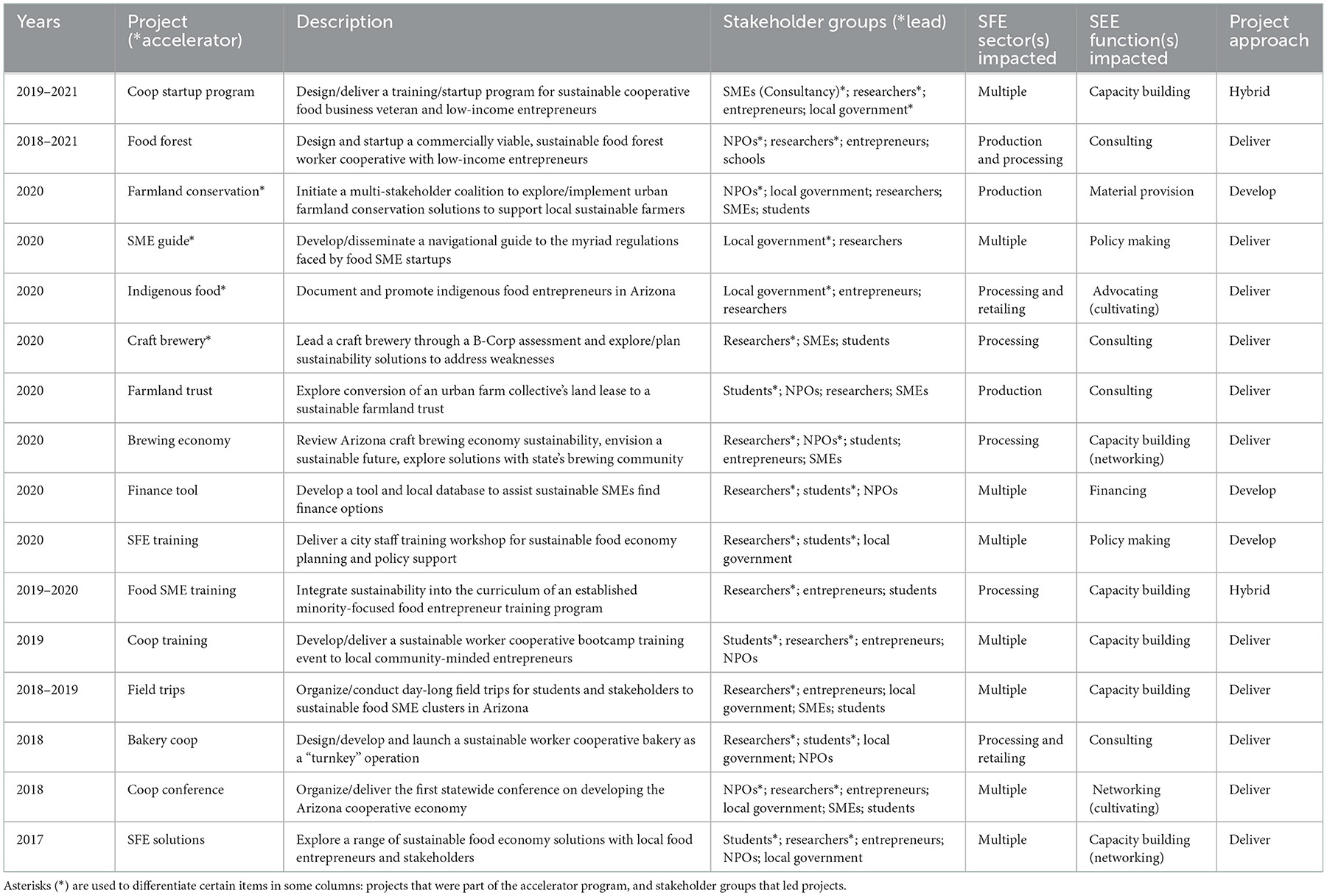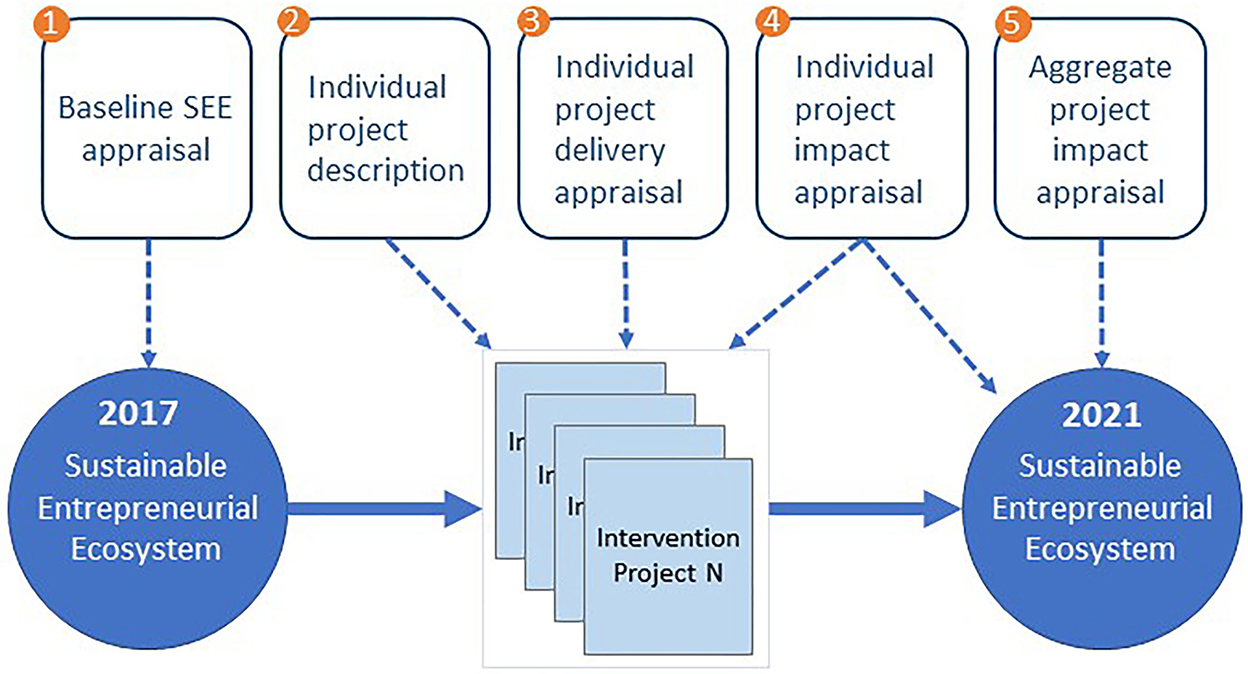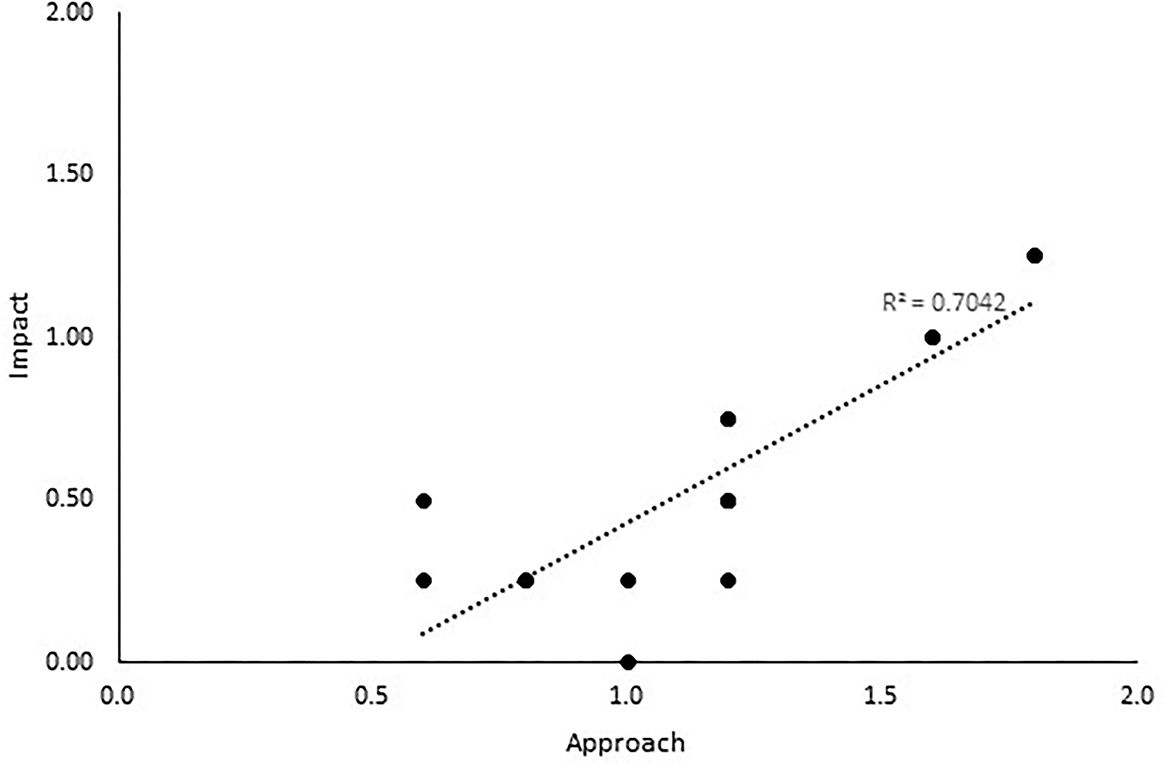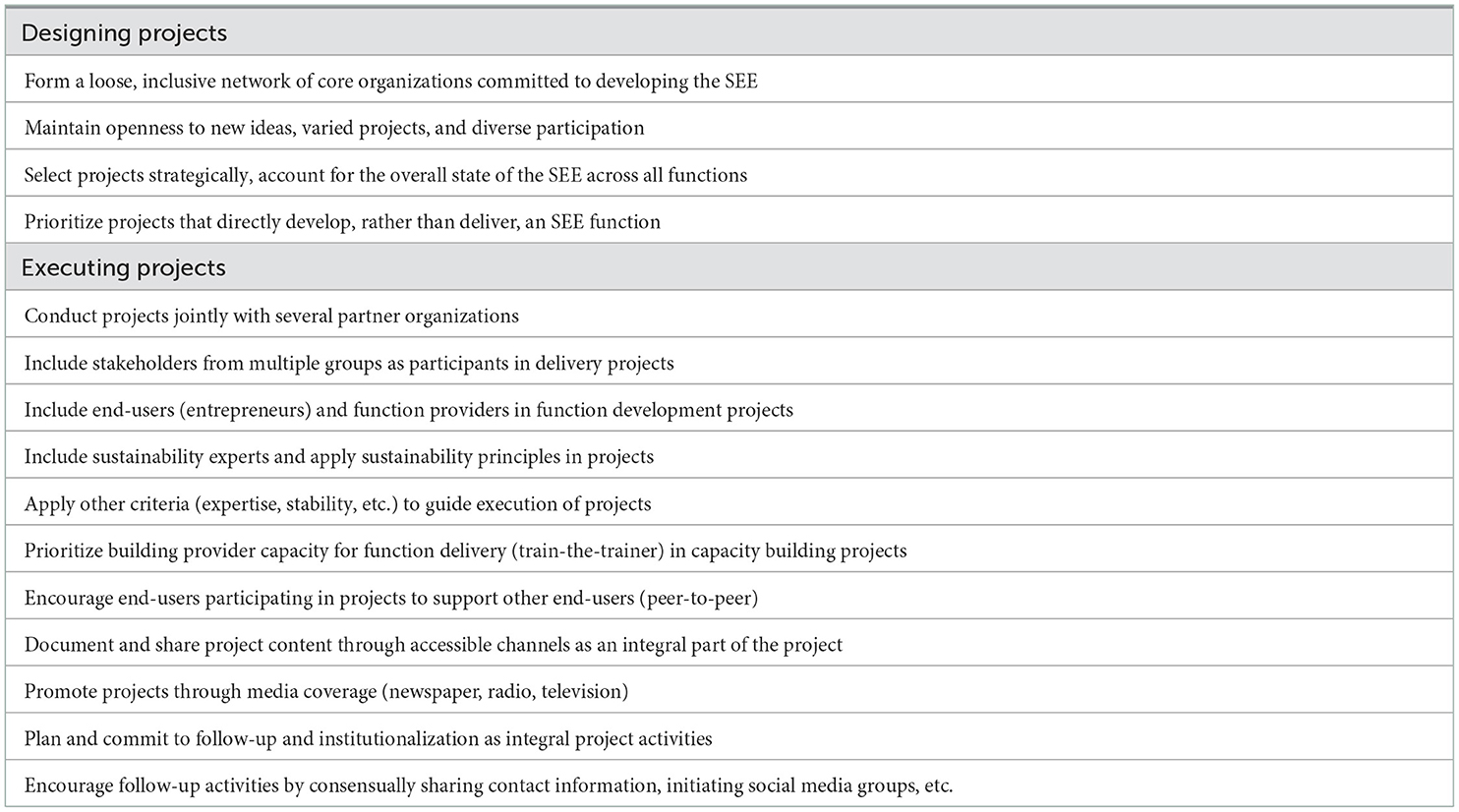- 1Sustainable Food Economy Lab, School of Sustainability, College of Global Futures, Arizona State University, Tempe, AZ, United States
- 2School for the Future of Innovation in Society, College of Global Futures, Arizona State University, Tempe, AZ, United States
Strengthening the sustainable entrepreneurial ecosystem (SEE), particularly its support functions for small to medium-sized enterprises (SMEs), is increasingly seen as an important means of accelerating the transformation to a sustainable economy. Little is known, however, about how to strengthen SEEs. In this article, we evaluate a series of 16 projects intended to develop SEE functioning to accelerate transformation to a sustainable food economy in the Greater Phoenix Area of Arizona. We use an evaluative framework designed around a set of ten SEE support functions to qualitatively assess the baseline state of the SEE, how projects were executed, the effects of these projects, and the overall changes in the SEE that resulted. The findings indicate all but one projects had positive effects on the SEE (nine weak, six medium). In conjunction with other developments, the projects raised the overall SEE performance from the baseline state of two functions being performed at only minimal level, to six functions being performed minimally, and one at a medium level. Insights gained from comparing results across projects suggest tentative guidelines for future practice, which should be useful for SEE stakeholders, including policy makers, economic development agencies, financial institutions, consultants, and educators, interested in strengthening SEEs. Researchers engaging in studies on strengthening SEEs may benefit from the evaluative framework enabling larger cross-case comparisons.
1. Introduction
Urgent sustainability challenges such as climate change necessitate an accelerated transformation to a sustainable economy in which economic sufficiency, ecological integrity, and social justice are simultaneously pursued rather than prioritizing growth and profit (Jackson, 2016; Raworth, 2018). Small to medium-sized enterprises (SMEs) utilizing sustainable business models and practices play an essential role in such a transformation (Anglin, 2011; Rhydian Fôn and Cato, 2014; Parker, 2017; Briamonte et al., 2021). Yet, individual businesses and entrepreneurs cannot do this alone: a sustainable entrepreneurial ecosystem (SEE) with various support functions is required for sustainable SMEs to thrive (Cohen, 2006).
SEEs are composed of economic actors (e.g., SMEs, suppliers, customers) and various support organizations—all committed to using and supporting sustainable models and practices (Forrest et al., 2022). SEE actors include entrepreneurs, government, investors, educators, consumers, and others who exchange information, knowledge, and resources, and otherwise interact to support sustainable business practices (Cohen, 2006; Fichter et al., 2016; Bischoff and Volkmann, 2018; Volkmann et al., 2021). The SEE concept recognizes that entrepreneurs (including entrepreneurial SMEs) belong to a broader entrepreneurial ecosystem (EE) and their success in adopting sustainable practices is often predicated on support received within this EE (Cohen, 2006; Fichter et al., 2016; Bischoff and Volkmann, 2018; Volkmann et al., 2021; Wiek and Albrecht, 2022). Such support comprises a range of EE functions, such as financing, capacity building, and policy making (Forrest et al., 2022). Actors involved in performing these functions may vary from place to place and with the SEE's stage of development, but entrepreneurs are most effectively supported when all functions are provided. Accelerating the transformation to a sustainable local economy, which depends upon the uptake and scaling of sustainable business practices by SMEs, is therefore best achieved by developing the functions of an SEE.
SEE research is an emerging field and the literature is still rather limited (Volkmann et al., 2021). It includes conceptual articles describing the general nature of SEE in terms of stakeholder composition (Fichter et al., 2016; Bischoff and Volkmann, 2018), the actors, activities, and resources involved (Cohen, 2006), or the functions they perform (Forrest et al., 2022). Several empirical studies explore actual SEEs in different regions and economic sectors (Cohen, 2006; Pankov et al., 2019; Bischoff, 2021; DiVito and Ingen-Housz, 2021), providing insights into contextual factors and actions that may increase SEE effectiveness. The literature, however, pays little attention to the development of SEEs, and lacks substantive engagement with the sustainability dimension of SEE (Forrest et al., 2022).
The literature on SEEs builds on that of general entrepreneurial ecosystems (EEs), and assumes SEEs are specialized versions of EEs (Cohen, 2006; Bischoff and Volkmann, 2018; Volkmann et al., 2021). The overriding message is that EE development is a dynamic process, greatly influenced by context and stakeholder agency (Feldman, 2014), and a bottom-up, systemic, multi-stakeholder approach is advised (Feldman and Francis, 2004; Isenberg, 2010; Stam, 2015; Feldman and Storper, 2018). While some general principles are discernible on how EEs and, by extension, SEEs should be developed, they are neither specific nor comprehensive enough to be of practical use in sustainability-oriented policymaking or practice.
Against this background, this study asks how SEEs can be purposely developed to accelerate the transformation to a sustainable economy. We address this question through an ex-post evaluative case study of 16 projects to develop the SEE and hence accelerate the transformation to a sustainable food economy (SFE) in the Greater Phoenix Area of Arizona. The projects were conducted by the Sustainable Food Economy Lab at Arizona State University in cooperation with various partner organizations between 2017 and 2021. The focus was on the food economy due to shared interests, knowledge, and networks of the partners, and the opportunities for generalizable insights afforded by topically related projects.
The study makes several contributions to the theory of SEEs. First, it is an empirical contribution to a gap in the literature on developing SEEs, namely, on how different types of projects and approaches may affect the development of SEEs. Second, it generates somewhat generalizable knowledge, in the form of guidelines, of use to practitioners developing SEEs, including policy makers, economic development agencies, financial institutions, consultants, and educators. The study demonstrates that SEEs can be successfully developed, even with limited means, which should provide motivation to cooperate across stakeholder groups on such efforts. The guidelines then offer specific empirically-based advice on how to develop SEEs, which should enhance stakeholders' effectiveness in doing so, e.g., when developing sustainable financing options for sustainable SMEs, irrespective of the specific economic sector. And third, the developed and applied evaluative framework should be useful for researchers engaged in studies on strengthening SEEs by providing a methodological base for robust evaluations while allowing cross-case comparative studies through standardized variables and data collection methods. Larger cross-case comparisons will support further empirically-based theory building.
2. Advancing the sustainable food economy in Phoenix
The Sustainable Food Economy Lab (SFE Lab) together with other research units at Arizona State University and local stakeholders, conducted a series of 16 projects over the ~5-year period to December 2021, with the goal of accelerating transformation toward a sustainable food economy in the Phoenix area. The projects were designed and executed using a transdisciplinary sustainability research approach (Lang et al., 2012), engaging local food entrepreneurs and SMEs, local government, and non-profit organizations (NPOs) in developing practical solutions to sustainability problems whilst building broader stakeholder capacity and generating new, solution-oriented knowledge. The projects varied in scope, approach, and objectives, and in the participating SMEs and economic development organizations (Table 1).
Within the overall project series, a more formal partnership of academic, public, and civic sector actors was formed to explore the establishment of an “accelerator” platform to advance the Phoenix area sustainable food economy. The partnership included a university research group (Arizona State University; the authors and graduate students), staff from metropolitan area cities (City of Phoenix, City of Tempe), and a local economic development NPO (Local First Arizona). Four pilot projects, each led by one of the partners and supported by the others, were conducted in 2019–20 to learn about and explore the potential of establishing such an accelerator for the longer-term.
While this study's focus is SEE development, the ultimate goal is to advance the sustainable food economy. Drawing from literatures on food systems sustainability (Eakin et al., 2017; Briamonte et al., 2021; McGreevy et al., 2022), alternative food networks (Feenstra, 1997; Marsden, 2010), and sustainable economies (Anglin, 2011; Rhydian Fôn and Cato, 2014; Raworth, 2018), a regional food system can be conceptualized as a network of food businesses (incl. production, processing, distribution, and outlets) and their interactions with each other, with customers, and with other stakeholders, exchanging food products, money, information, knowledge, skills, business practices, and so forth within a region (geographical or administrative unit). What makes such a food system sustainable is compliance, at the levels of individual businesses, supply/value chains, and the entire network, with a comprehensive set of sustainability principles “prioritizing sufficiency over efficiency, regeneration over extraction, distribution over accumulation, commons over private ownership and care over control” (McGreevy et al., 2022). A sustainable entrepreneurial ecosystem supports compliance with these principles through sustainability-oriented policy making (e.g., enabling land access for sustainable food businesses), capacity building (e.g., training on how to start a sustainable food cooperative), material provision (e.g. renewable energy for food businesses), networking (e.g., connecting short food supply chain stakeholders), financing (e.g., social financing for food businesses) (Howard, 2009; Briamonte et al., 2021; McGreevy et al., 2022), and other such functions. In the SFE lab, we have used an adapted version of the B-Lab's assessment framework (Honeyman et al., 2019) to evaluate a variety of SFE-related entrepreneurial projects, businesses, supply chains, and sectors against comprehensive social, environmental, and economic sustainability criteria aligned with the above principles.
Over the course of conducting these projects, the idea of an institutionalized SFE accelerator emerged – hence the accelerator partnership mentioned above. An accelerator is usually conceptualized as an organization that speeds up business startup through a competitive, cohort-based, time-limited program in which entrepreneurs receive training, mentoring, networking, and seed-funding, often culminating in matching startups with investment opportunities and customers (Hochberg, 2016; Goswami et al., 2018). An accelerator, in this sense, is concerned with individual business development and, from an EE perspective, offers multiple services that are difficult and time-consuming for startups to access (Hochberg, 2016). The SFE accelerator concept adopted by the accelerator partnership differs from the conventional in several respects: first, it is provided by a consortium of ecosystem stakeholders rather than an individual organization; second, it focuses on developing the food economy and not just individual food businesses; third, it considers services for businesses in all lifecycle stages, not just startups; fourth, it includes services and activities beyond startup programs; and fifth, its aim is the simultaneous pursuit of comprehensive social, environmental, and economic goals rather than high growth, economic value maximization.
3. Research design
The research consisted of a qualitative, ex-post analysis of the projects and their impact on the Phoenix area SEE. The research used a nested case study approach for both tentative explanatory and exploratory purposes, in which the primary unit of analysis was the SFE-related SEE of the Phoenix area and the nested units of analysis were the intervention projects (Yin, 2003). The study is explanatory for the potential insights it offers into how SEEs can be developed, and exploratory in its creation and use of a potentially generalizable evaluative framework which may benefit further studies. Despite being a single case, the study is worthwhile as it is “representative” and “revelatory” (Yin, 2003) insofar as the case is assumed to be broadly similar to other regions and thereby insights gained are somewhat generalizable. It offers an opportunity to study, for the first time, a series of related projects aimed at developing a particular SEE for which data are still readily available.
The research is also exploratory in that – in the absence of specific, relevant theories – it seeks to gain empirical insights that contribute to building theory on how to develop SEEs, rather than being theory- or hypothesis-driven (Eisenhardt, 1989). It is, however, broadly based on the general ‘theory' that may be interpreted from the EE literature that purposively developing EE is best pursued with a dynamic, bottom-up, multi-stakeholder-driven process (Feldman and Francis, 2004; Isenberg, 2010; Stam, 2015; Feldman and Storper, 2018). The research, therefore, focuses on the development approach and the impacts on the SEE, to look for possible causal effects and success factors.
We derive our research design on the basic logic model of intervention research (Fraser et al., 2009) in which an action or series of actions (interventions) are performed (delivered) for the purpose of generating outputs that lead to desired outcomes. Applying this to our study, we assess how the type of project (intervention) and the way it was performed (delivery) affected critical elements of the SEE (outputs) and the overall strength of the SEE (outcomes). To answer the research question, a five-step analytical procedure was followed (Figure 1) corresponding to five sub-questions:
1. What was the state of the SEE functions before the first project in 2017?
2. What were each project's characteristics and which SEE functions did they affect?
3. How were the projects executed with respect to SEE function development?
4. What was each project's impact on SEE function development?
5. What was the overall state of the SEE functions after the last project in 2021?
All research schema and analytical data are provided as Supplementary material to this article.
The pre/post SEE appraisals are based on data and knowledge acquired by the authors from their SFE-related work in the Phoenix area from June 2017 to December 2021, including participatory research, project-based teaching, conducting field trips, and being otherwise active in SEE development. The geographical scope, while centered on Phoenix, naturally extended to Arizona in some cases. Other lab projects, including conventional, non-participatory research, and projects in other geographical areas, were excluded as they did not intervene directly in the Phoenix area SEE.
Analysis is structured by Forrest et al.'s (2022) framework that decomposes the SEE into a set of functions (Table 2). These functions support the uptake of sustainable business practices by SMEs and development of the sustainable local economy overall. The primary SEE function of starting and running sustainable enterprises is fostered by a set of ten SEE support functions. The functional perspective focuses on performance, i.e., what does the SEE actually do, and indicates the range of actors that provide each function.
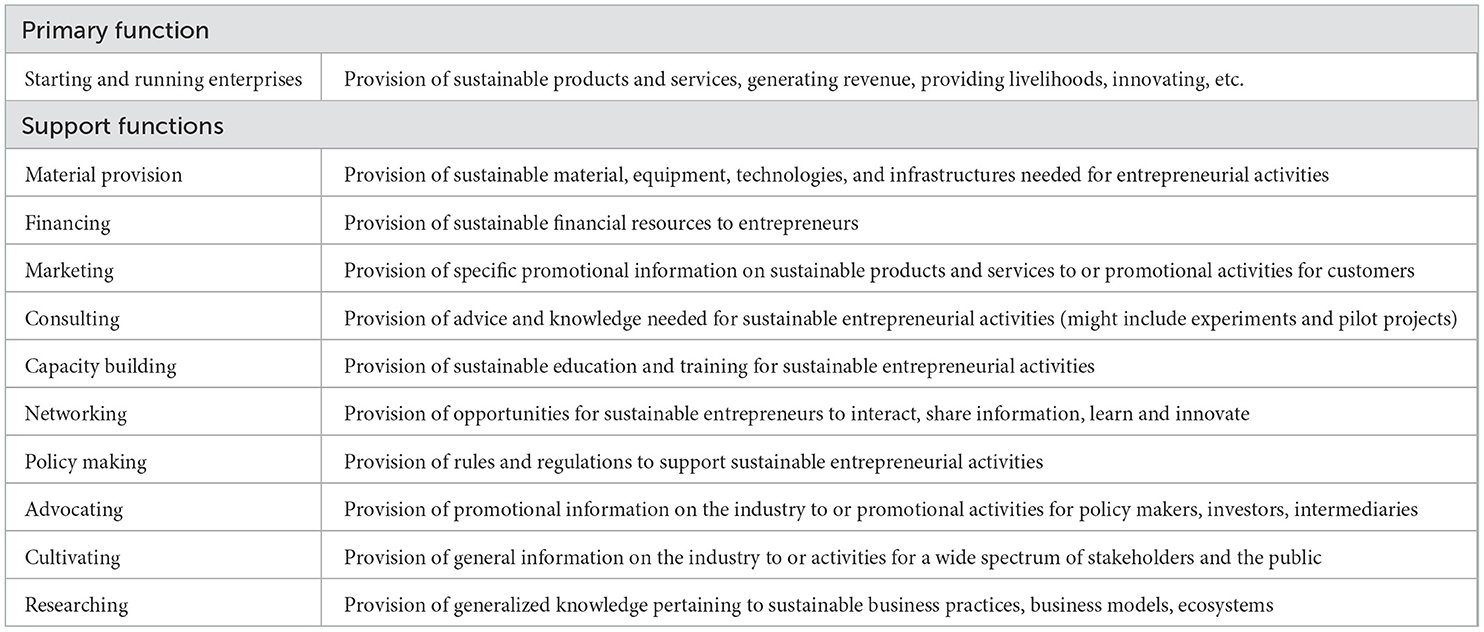
Table 2. Functions of SEEs (Forrest et al., 2022).
Projects may affect function development either by directly developing the function, or indirectly, by delivering (performing) the function, such as providing consulting services to an SME. Delivery projects are assumed to have a secondary effect on the function, beyond the immediate project scope (Figure 2).
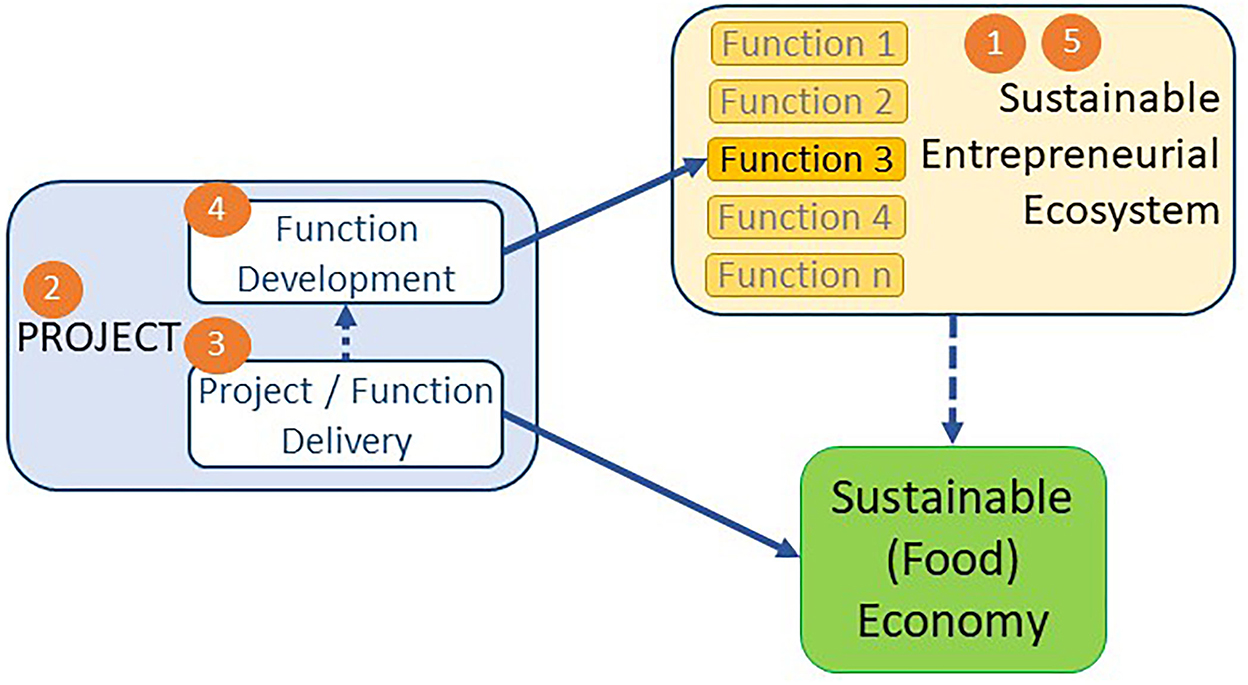
Figure 2. Analytical steps (numbered) in relation to project approach and impact on the SEE and the sustainable (food) economy.
Data on each project were collected by SFE Lab members as participant-researchers in the form of observations, notes, project reports, and reflections. The variety of sources and the differing involvement and perspectives of researchers provides some degree of triangulation, and therefore validity, of data. For the four accelerator pilot projects, additional data were also available from 90-min, semi-structured group interviews with personnel from each partner organization (seven interviews in total), asking participants to reflect on the partnership, the approach and process, the outputs generated, the outcomes, and the outlook.
Appraisal of projects and impacts on the overall SEE entailed detailed evaluation by one author, followed by more cursory evaluation by another author and discussion between the two to resolve differences, as well as a final review by the third author.
3.1. Step 1 - SEE baseline appraisal
We appraise the state of each SEE function in early 2017 (pre-intervention baseline) and their functional level. We first apply four criteria: Sustainability content; Expertise of providers; Inclusivity toward target audience; and Stability of delivery, using a three-point scale (weak – medium – strong) to appraise the fulfillment of each criterion. A rubric is then used to derive an overall function performance level, ranging from being missing (level 0) to fully functional (level 3). We also compiled a matrix of actors involved in each SEE function.
3.2. Step 2 - Project description
Projects are described using general profiles consisting of summary, timeframe, stakeholders involved, activities performed, outputs generated, economic sector, and the SEE function primarily developed.
3.3. Step 3 - Project execution appraisal
Project execution appraisal drew on insights from the entrepreneurial ecosystems literature (Isenberg, 2010; Feldman and Storper, 2018; Bischoff, 2021; DiVito and Ingen-Housz, 2021) and our own experience and knowledge. We use the four baseline criteria in a slightly modified version and add a fifth criterion, Integration with previous/parallel programs, to gauge how well projects were executed (i.e., how well the function was delivered and/or developed) using a three-point scale. The expectation is that projects that more closely follow those criteria in their approach will more positively impact function development.
3.4. Step 4 - Project impact appraisal
A project's impact on the SEE function is appraised by evaluating the degree to which four major functional components were generated by the project using a three-point scale. The components are: delivery documented; providers trained in delivery; delivery network strengthened; and delivery institutionalized.
3.5. Step 5 - Aggregate impact appraisal
To appraise the overall state of the SEE functions in late 2021, the aggregate impact of all projects on the baseline state of each function is qualitatively considered. The change in each function and its resultant new state is gauged across the same criteria and performance-level rubric used in the baseline appraisal.
4. Results
4.1. Phoenix area SEE baseline (2017)
The Phoenix area SEE was barely developed in 2017, with eight functions at level 0 (missing) and the remaining two at level 1 (minimal) (Table 3). At least 19 stakeholder groups were involved, including NPOs, local government, universities, and entrepreneurial individuals and businesses with most participating in multiple functions, and three in five (Table 8). The 2017 state of each function is briefly described below, including identification of stakeholders involved using abbreviated name codes, the function level, and an example of function delivery.
• Material provision (IRC, RISN, CoP, CoT, and ACFMA) – Level 0 (missing). Although several organizations provided material support, the range and availability were limited and there was little sustainability focus. For example, the NPO International Rescue Committee supports refugee farmers with access to urban farmland, but there was no program requirement to adopt sustainable practices (although many farmers already do).
• Financing (IRC, PREPPED, FZL, and VH) – Level 0 (missing). The number of providers, range of finance options, scope of financing, knowledge and skills of financing for sustainable SMEs was very limited. For example, the NPO Vitalyst Health provided competitive grants for health and nutrition projects, but generally not for business development, while Fuerza Local, a non-profit micro-business accelerator, awarded graduates a $1,000 stipend. Lacking, are local banks, credit unions, social investment firms, etc. offering appropriate finance for SMEs that often lack credit score/history or conventional security.
• Marketing (LFAZ, Entreps. LGN, and ACFMA) – Level 1 (minimal). Despite only three active organizations, they had notable success in developing sustainable food markets, particularly for fresh produce and grain products. However, the scale, range, and variety of efforts was limited. For example, the local grain network, including entrepreneurs, businesses, and support organizations, grew the local grain economy from scratch in 2011 to $1 million by targeting supply and demand-side development of local baking and brewing businesses (Forrest and Wiek, 2021).
• Consulting (TNC, Entreps, LGN, RISN, ACI, ACLT, and MCDHS) – Level 0 (missing). A healthy number of organizations were providing various consulting services, but expert help for key business development services was limited and sustainability was not a key element. For example, the Arizona Co-operative Initiative NPO offered cooperative development support but without specialized legal or accounting expertise, or sustainability framing.
• Capacity building (MCCXS, IRC, TNC, Entreps, PREPPED, FZL, SVFB, ACI, and MCDHS) – Level 0 (missing). Strong entrepreneurial capacity-building programs for underserved groups existed, but they were still establishing themselves, did not meet the demand, and lacked attention to alternative organizational models (e.g., cooperatives) and sustainable practices. For example, the PREPPED food micro-business accelerator, offering free training to underserved minorities and women, was proving successful but had only been operating for one year, and sustainability was not a key element.
• Networking (MCCXS, LFAZ, TNC, Entreps, PREPPED, LGN, FZL, VH, PP, RISN, CoP, CoT, ACFMA, and MCDHS) – Level 0 (missing). Well-established networks supported the sustainable food economy but lacked open forums (vs. intermediated connections), bottom-up entrepreneurial drive, members from critical fields, overarching sustainability purpose, and high cultural diversity. Only one organization—the NPO Local First Arizona—was conducting regular networking opportunities, such as its annual Farmer-Chef event, for local food entrepreneurs and supporting stakeholders.
• Policy making (LFAZ, VH, PP, SVFB, CoP, CoT, and MCDHS) – Level 0 (missing). Although there were committed and capable organizations involved in policy making, the number of organizations, their diversity and inclusivity, resources, coordination, and sustainability focus were generally too limited to significantly impact sustainable food economy policy. One exception, Pinnacle Prevention, a health promotion NPO, was leading efforts to extend government food stamps to include locally produced foods available at farmers' markets, though without a sustainability focus.
• Advocating (LFAZ, IRC, VH, PP, and ACLT) – Level 0 (missing). A few committed organizations were effective advocates for some aspects of a sustainable food economy, but lacked inter-organizational leadership, in-depth sectoral knowledge, and application of sustainability. For example, Vitalyst Health, a health promotion NPO, was a strong voice for health solutions, community gardens, urban farming, and farmers' markets, but with little regard for the overall food economy (e.g., processing or distribution sectors) or broad-based sustainability.
• Cultivating (LFAZ, IRC, TNC, Entreps, PREPPED, LGN, and FZL) – Level 1 (minimal). A small number of committed organizations were nurturing a culture of diverse, locally focused, community-minded food entrepreneurship although lacking clear and explicit focus on sustainable business models and practices. Local First Arizona was leading here, again, through public events, partnerships, conferences, media connections, and information tools.
• Researching (MCCXS and ASU) – Level 0 (missing). While valuable food systems research was being conducted, it was not particularly relevant to the local sustainable food economy, few research organizations were involved, it was uncoordinated, and was not stakeholder-engaged. Arizona State University research consisted of, for example, studies investigating food deserts, information signals at farmers' markets, or the health impacts of community supported agriculture. While advancing knowledge generally, there was no research directly supporting local businesses or stakeholders, or SEE function development.
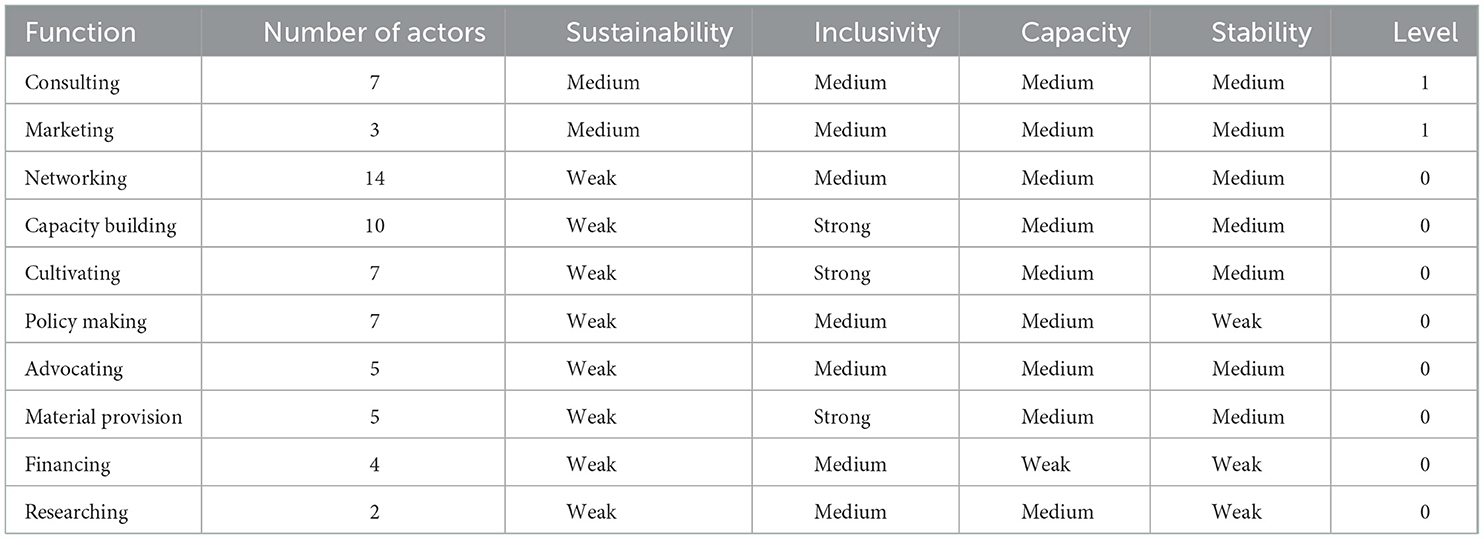
Table 3. The state of Phoenix area SEE functions in 2017 (baseline) with number of actors involved in each function, appraisal of criteria for function strength, and overall function performance level (0 = missing, 1 = minimal, 2 = intermediate, 3 = full).
4.2. Projects
The overall set of projects is described here in terms of aggregate characteristics (Table 4). Half of the projects (8) cut across multiple (>2) economic sectors, e.g., the cooperative training program projects, or the craft brewing economy project, while the remaining projects were on production, processing, or dual sectors. Multiple stakeholders were involved in most projects, with researchers and students being most frequently involved. Projects concentrated on developing Capacity Building (6) and Consulting (4) functions, while several functions were developed by only one or two projects, and three (3) were not developed by any project. Most projects (11) delivered rather than developed the respective SEE function, while only three (3) focused on function development (3), and two adopted a hybrid approach.
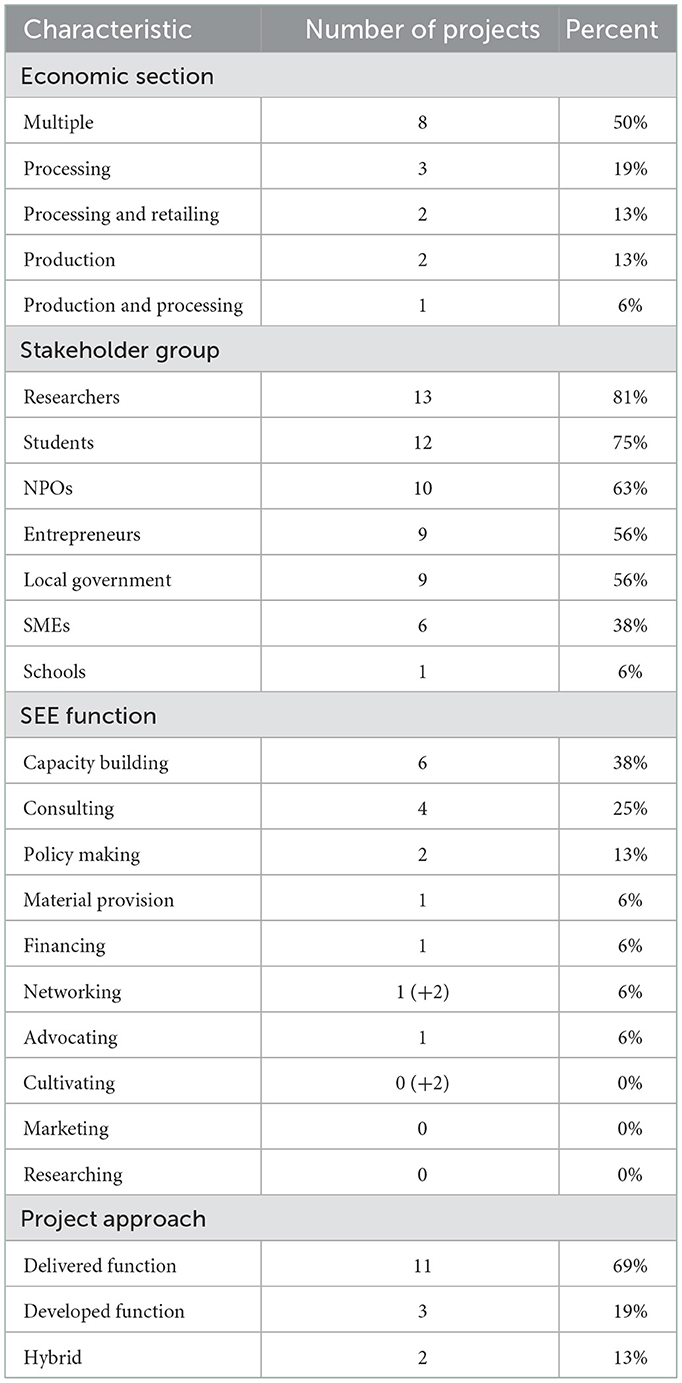
Table 4. Aggregate profile of the set of projects: a) economic school sector; stakeholders involved; primary SEE function; and project approach.
4.3. Project execution/approach
The projects delivered/developed the respective function well, with 11 projects achieving at least a medium (=1) score on at least four of the five appraisal criteria (Table 5). Of those 11 projects, all but two were capacity-building and consulting function projects—perhaps a result of these projects being co-initiated and/or co-led by a university research and teaching group. Similarly, as all of the projects were designed to advance the sustainable entrepreneurial ecosystem, it is not surprising that all but one (15 out of 16) achieved at least a medium score on “sustainability” (11 – high score; 4 – medium score). At the bottom are projects that focused on the delivery/development of a policy document (SME Guides) and a tool (Finance Tool).
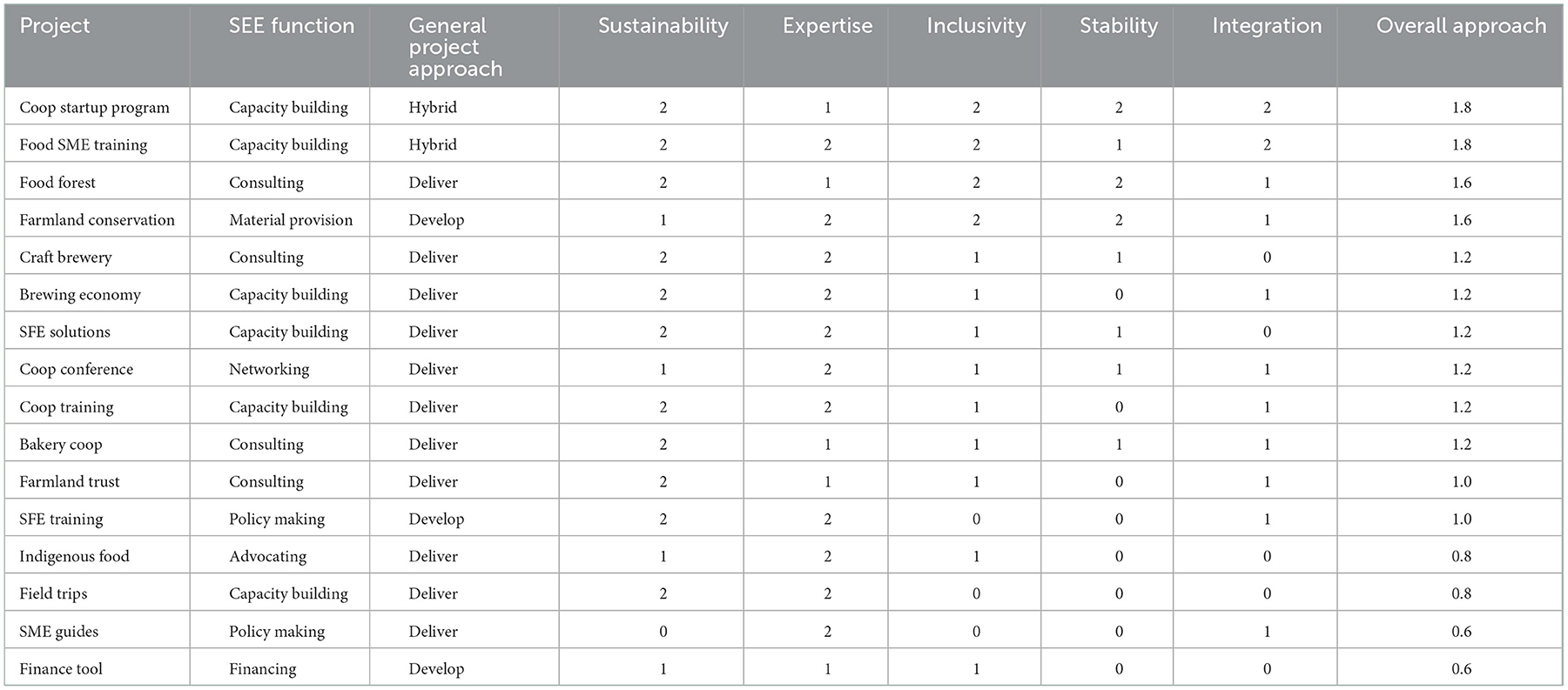
Table 5. Summary appraisal of project approach across five performance criterion (0 = weak, 1 = medium, 2 = strong) and overall approach (mean).
4.4. Individual project impact on SEE functions
Almost all projects (15 of 16) had a positive effect on at least one SEE function (Table 6). Yet, the impacts were mostly weak (up to 0.5-score) to medium (0.75-score or higher, but less than 1.5), with nine projects having a weak impact and six projects having a medium impact. Only three projects had a strong impact on at least one element. Documenting the delivery was the weakest area with only four projects (25%) having a medium impact, and none having a strong impact. Institutionalizing the delivery and strengthening the delivery network fared better with six and nine projects (38 and 56%) having a medium or strong impact respectively. Projects were most successful, though, at training providers in delivery, where thirteen projects (81%) had a significant effect—again, not surprising considering the educational mission of the SFE Lab. Overall project impacts averaged across impact areas, ranged from weak to medium (0–1.25). The top three projects were development or hybrid types, suggesting delivery projects are less effective in the development of SEE functions.
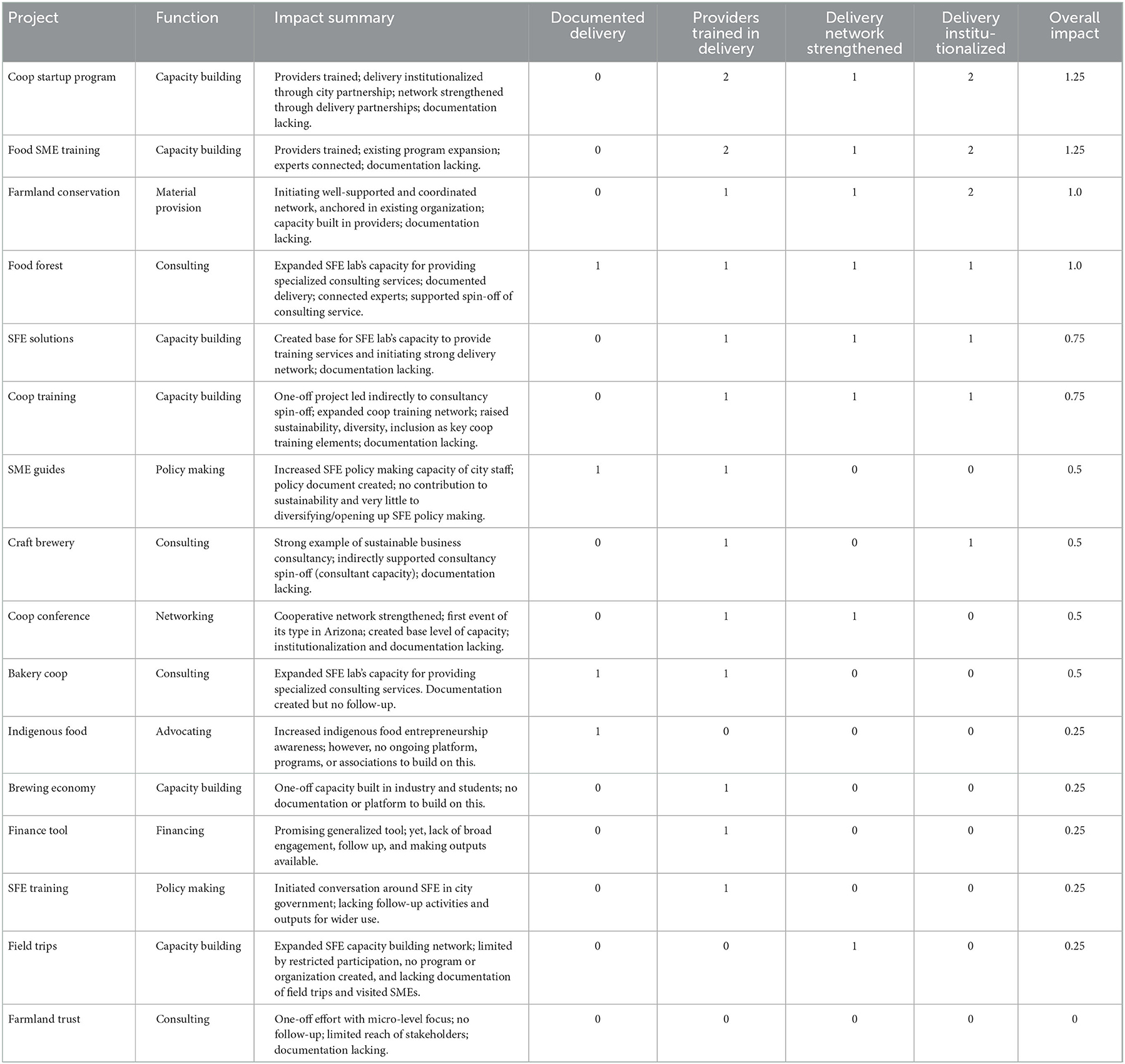
Table 6. Summary appraisal of each project's impact on SEE function elements (0 = weak, 1 = medium, and 2 = strong), and overall impact rating (mean).
4.5. Aggregate impacts on the SEE
Here, we consider the cumulative impact of projects and other developments [e.g., new organizations formed or expanded scope of existing organizations (Table 7)] on the state of SEE functions by 2021. Overall, the projects' contribution to most SEE functions has been positive (Table 8). Three functions (Capacity building, Consulting, and Researching) increased a full level from the 2017 baseline; three additional functions (Networking, Policy making, and Advocating) began to take-off; and one function (Marketing) stayed on the same level. Greater sustainability focus was critical to these improvements. Other contributing changes include more organizations being involved, shifts in existing organizational scope, and growing expertise within many functions. However, deep subject knowledge, skills, tools and resources are still lacking; the numbers and scope of organizations involved are still relatively low, with the sustainable food economy being of only secondary importance to many of them; function provision is of limited availability; and sustainability and its operationalization are still weak. There is also not yet a coherent approach to coordinate function delivery and SEE development.
• Material provision (1 project; +2 organizations: FZL, SoO) – Level 0 (unchanged). One project (Farmland Conservation) contributed significantly, particularly in establishing a new, multi-stakeholder organization committed to supporting small farmers. This increased function stability and to a lesser degree, capacities to perform the function. A new urban farming organization (Spaces of Opportunity) provides lots to small farmers, and an existing incubator program (Fuerza Local) now offers cooperative commercial kitchen space. While positive, the impacts have been insufficient to nudge the function's strength up.
• Financing (1 project; +3 organizations: LFAZ, TNC, SBA) – Level 0 (unchanged). One project (Finance Tool) created a potentially useful, generalized tool, but of limited access and usability. In other developments, one NPO (Local First Arizona) extended its expertise by participating in a Transform Finance workshop, while another NPO (The Nature Conservancy) took the unusual step of investing in a small craft malting business, and the federal government (Small Business Administration) extended loan guarantees to employee-owned businesses. Project impact was negligible and while the other developments increased expertise (weak to medium), this was insufficient to raise the function's level.
• Marketing (0 projects; +1 organization: TNC) – Level 1 (unchanged). No projects aimed directly at marketing. One NPO (The Nature Conservancy) became directly involved in developing supply and demand sides of locally grown grain markets. While TNC's involvement was significant, it was insufficient to raise the function's level.
• Consulting (4 projects; +4 organizations: SFEL, LFAZ, SBA, TC) – Level 2 (+1). The function was indirectly developed through four delivery-type projects (Food Forest, Bakery Coop, Craft Brewery, and Farmland Trust) by a university lab (SFEL). The Food Forest project made the strongest contribution (medium), whilst the others had weak effects (Table 6). Cumulatively, the projects established the SFE Lab as a consulting organization, albeit of varied, irregular, and limited services, and their aggregate impact increased the sustainability focus of this function (previously absent from consultancy offerings). A new sustainable business development consultancy (Thrive Consultancy) was formed as an SFE Lab spin-off. In addition, an NPO (Local First Arizona) started a green business certification service, and the federal government (Small Business Administration) nominally extended its SME support to employee-owned businesses. Overall, the range of organizations and services significantly increased, along with the knowledge and skills base, and a greater focus on sustainability. Gaps in capacity still exist (e.g., legal and accountancy) and the range of services and availability needs to be further developed to reach full functionality (level 3).
• Capacity building (6 projects; +4 organizations: SFEL, SoO, CoP, TC) – Level 1/2 (+0.5). Most projects were capacity building activities with entrepreneurs and stakeholders delivered by a university lab (SFEL), including one-off workshops and events (Brewing Economy; SFE Solutions; Coop Training) and occasional activities (Field Trips). Two projects, however, developed the function directly, extending existing or creating new training programs with established partners, including “train-the-trainer” activities (Food SME Training; Coop Startup Program). All projects were strongly sustainability-oriented. In addition to the SFE Lab becoming a capacity building provider, an NPO coalition founded a community-based urban farm providing training for farmers (Spaces of Opportunity), a local government expanded its community development to provide sustainable food entrepreneurial training (City of Phoenix), and a new SFE Lab spin-off consultancy offered training on sustainable business practices (Thrive). Function stability and capacity have been significantly increased with two new or enhanced programs and three additional organizations, while the capacity for delivering capacity building has been broadened across these and other organizations. These positive changes result in an increase in overall functionality.
• Networking [1 project (2 projects indirectly); +3 organizations: SFEL, MARCO, ACI] – Level 0/1 (+0.5). One project focused on networking (Coop Conference) in which the SFE Lab partnered with an NPO (Arizona Co-operative Initiative) to organize the state's first cooperative economy conference. Whilst it was a strong networking event, it made little contribution to ongoing networking support due to a lack of follow-up and documentation. Two projects (Brewing Economy, SFE Solutions) facilitated new connections between economic actors. In addition, a new NPO coalition formed (Maricopa County Food Coalition) to further the local food system with networking as one of its primary purposes. An increase in stability (more organizations) and a shift toward sustainability have been enough to slightly boost function strength.
• Policy making (2 projects; +2 organizations: SBA, ASU) – Level 0/1 (+0.5). One city government project aimed to directly reduce policy barriers to small food business (SME Guides) while the SFE Lab provided policy-oriented SFE training to another city government's staff (SFE Training). These projects increased awareness and commitment by city governments and helped one (City of Phoenix) obtain major federal funding (Phoenix Resilient Food System Initiative). Additionally, the policy scope of a federal agency with local operations (Small Business Administration) expanded to include employee-owned businesses, while a new Arizona State University center (Swette Center for Sustainable Food Systems) engaged in multi-level policy work. Both projects and the other developments have therefore had some impact, moving this function close to takeoff.
• Advocating (1 projects; +3 organizations: SFEL, MARCO, ASU) – Level 0/1 (+0.5). One project (Indigenous Food) directly advocated for indigenous food entrepreneurs but did not develop the function beyond this. Three new organizations (SFEL, Maricopa County Food Coalition, Swette Center), all with a sustainability orientation, engaged in SFE-related advocacy including informal interactions, meetings, public events, media engagement, social media, and website communications. This expansion of the organizational base has moved the function close to takeoff.
• Cultivating [0 project (2 projects indirectly); +1 organization: SoO] – Level 0 (unchanged). No projects aimed directly at Cultivating; yet, two projects (Indigenous Food; Coop Conference) made indirect contributions. In addition, one new organization (Spaces of Opportunity) was created to develop a local food culture through a community-based urban farm and food hub. Despite these positive changes, the overall impact on the function is too small for a shift.
• Researching [0 projects (several indirectly contributing); +3 organizations: SFEL, MARCO, ASU] – Level 1 (+1). None of the projects aimed directly at Researching. However, the SFE Lab, a new non-profit coalition (Maricopa County Food Coalition), and a new (research) center at Arizona State University (Swette Center for Sustainable Food Systems) conducted research on the sustainable local food system. An increase in stability (more organizations) with greater focus on coordinated, locally-relevant research performed through a sustainability lens takes the overall function performance to level 1.
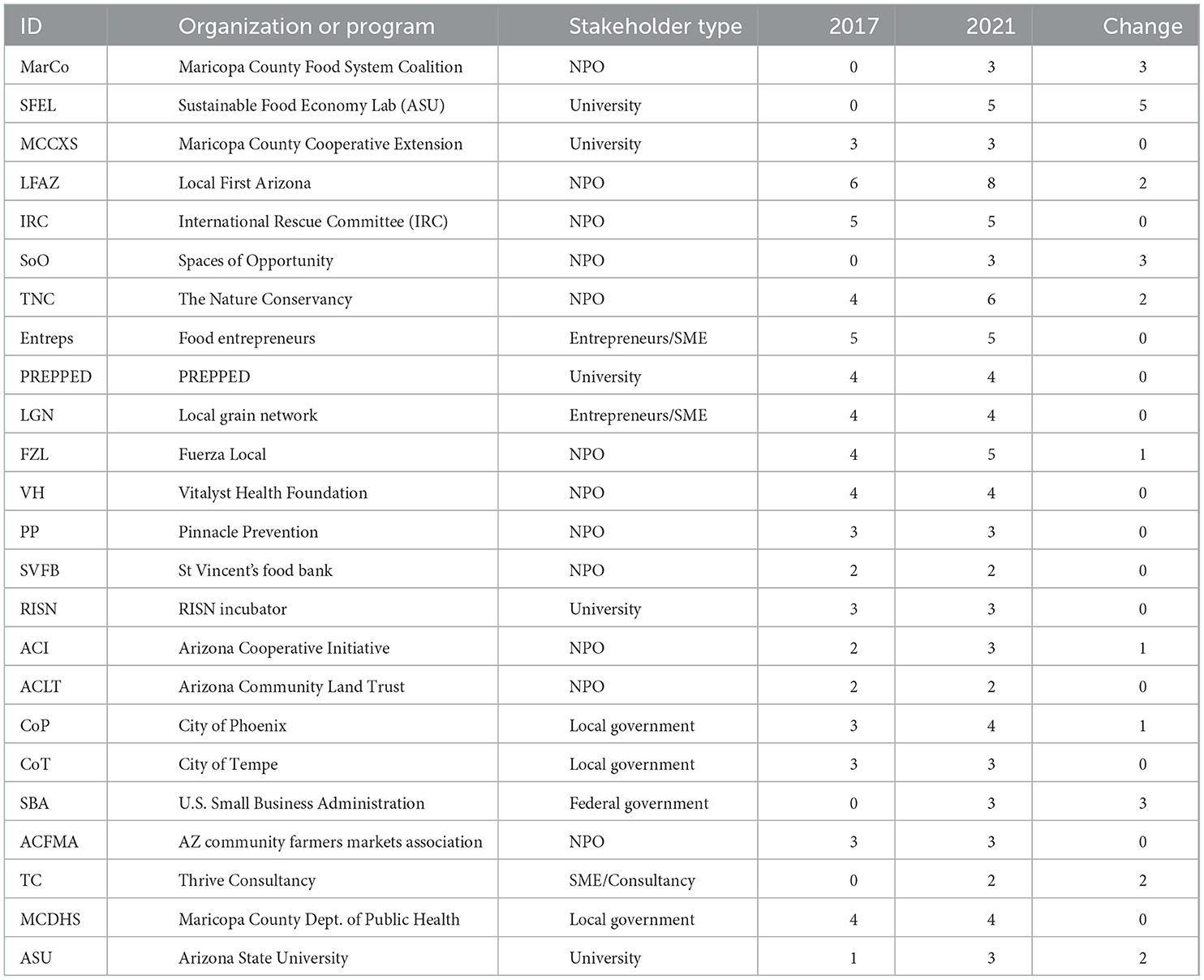
Table 7. SEE stakeholders in the Phoenix area, showing the number of functions participated in in 2017 and 2021 and the net change.
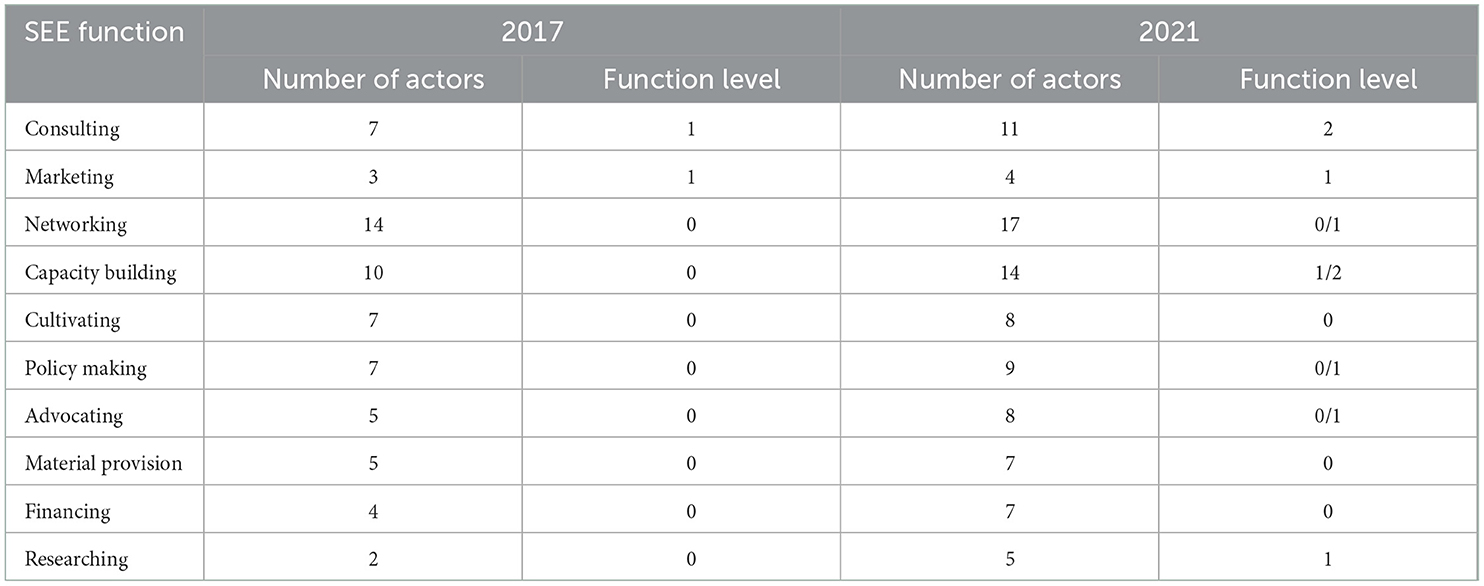
Table 8. The number of actors involved and overall function performance level (0 = missing, 1 = minimal, 2 = intermediate, 3 = full) of Phoenix area SEE functions in 2017 vs. 2021.
4.6. Link between approach and impact of the projects
The above appraisals tentatively suggest a positive relationship between project approach and project impact, indicating the more sustainability, expertise, inclusivity, stability, and integration that goes into a project, the greater the impact in terms of documented delivery, providers trained in delivery, delivery network strengthened, and delivery institutionalized (Figure 3).
5. Discussion
The results indicate a strengthening of the Phoenix area's SEE that is partly attributable to the projects conducted between 2017 and 2021, but also that there is room for improvement in designing and executing projects to increase their impact on the SEE. Along these lines, the results are discussed below to tease out some tentative guidelines (Table 9).
5.1. General project approach
Projects leant toward delivering rather than developing SEE functions, focusing on providing direct value to end users (e.g., entrepreneurs), thereby limiting impacts on function providers. Delivery projects can have co-benefits, such as developing the project team's capacity and creating knowledge or tools, as seen in the Coop Training project that educated the delivery team and prototyped a training module. Delivery projects may achieve greater impact by broadening their reach beyond a single end-user organization or by including at least one function provider. For instance, while the Craft Brewery project's benefits were limited to staff from one SME, the Brewing Economy project reached over a dozen entrepreneurs from multiple SMEs and numerous other ecosystem stakeholders. Development projects can also be of limited impact if they are narrowly focused or lack stakeholder engagement. For example, the SME Guides and Finance Tool projects both created useful knowledge but failed to engage entrepreneurs or function providers to use the knowledge. Hybrid projects combine the benefits of function delivery and development as seen in the two most impactful projects: the Coop Startup Program and the Food SME Training. They both involved directly working with entrepreneurs, while simultaneously training function providers (train-the-trainers) and developing material for function provision.
5.2. Specific project approach features
Too many projects were one-off actions with no planning or preparation for post-project delivery stability. These projects failed to follow up on opportunities created, capacity built, or connections made. The SFE Training project, for example, whetted the appetite of local entrepreneurs and government staff but went no further. Another weakness was integration: most projects did not build upon previous or parallel projects and activities, foregoing the benefits of prior investment to form partnerships, develop concepts and materials, win broader support, etc. One such project was the Indigenous Food project that, while promoting a much-neglected aspect of the food economy, had little connection to accelerator partners or their previous work. Inclusivity was moderately strong overall but weak in engagement, where few projects involved entrepreneurs in broader planning and development to enhance relevance, practical knowledge, and empowerment. For example, the Coop Bakery project approach was top-down, lacking any entrepreneur-level involvement that likely contributed to its failure. In contrast, entrepreneurs were highly engaged in the similar startup-type Food Forest project that ultimately made it to implementation. In another aspect of inclusivity, the four most impactful projects all involved multiple organizations in planning, development, and delivery, whereas most of the least impactful were conducted by single organizations. Inclusivity was also weak regarding specialist lawyers, finance experts, and business developers because the Phoenix area lacks such professionals with suitable sustainability expertise. Sustainability was the strongest approach feature, largely because of the SFE Lab's involvement, which prioritized sustainability as an outcome and designed projects accordingly. Projects that had little SFE Lab involvement were notably weak in sustainability.
5.3. Project impacts
Many projects had a limited impact because materials produced were not made widely accessible. For example, the Finance Tool, SFE Training, Brewing Economy, and Coop Conference projects produced useful data, tools, and insights, yet published none of it. Only four projects made documentation available, and even these were of limited practical usefulness. The Food Forest project, for example, produced a range of high-quality documentation, but on a specialized topic with limited general applicability. Documentation by media coverage as seen in the Coop Conference project, though effective at raising awareness and interest, lacks detail and completeness. Regarding institutional outputs consolidating and continuing project work, only three projects established organizations or programs of functional significance. And though many projects made post-project connection between participants possible (e.g., the Coop Conference and Brewing Economy), none enhanced a function's networking capabilities. The most commonly developed functional component was capacity. It was strongest in the only two projects that targeted training of function providers (Coop Startup and Food SME Training projects). The lack of impacts can be partially attributed to limited project funding which often requires moving on to the next project without documenting or institutionalizing delivery.
Less apparent from these results is the cumulative effect of projects on delivery expertise and networks. For example, the Coop Startup Program, one of the most effective projects undertaken, had roots in the Coop Training project, but there was no planned pathway to it. Through conversations around other projects and participation in the accelerator partnership, new connections formed between local government staff and the SFE Lab that led to city interest in providing cooperative food business training. Meanwhile, SFE Lab graduates who participated in the Coop Training project started a sustainable business consultancy. Convergence of goals and capabilities brought the three organizations (lab, city and consultancy) together to iteratively develop and arrive at the current coop startup program. Generally, the series of loosely connected, though unplanned, projects has gradually increased stakeholders, knowledge, focus, and interactions around the sustainable food economy, that have led to significant impacts. Important elements of such developments seem to be an openness to new ideas, a wide range of projects, and diverse participation.
5.4. Project selection
Projects were selected opportunistically according to available capacities and resources rather than which functions most needed strengthening. Focusing on a few functions that make best use of scarce resources and capabilities was a reasonable approach in the early stage of SEE development; yet, as the SEE develops, a more strategic approach is needed. Indeed, this opportunistic project selection may result in particular SEE functions becoming more developed as a result of the project developer capabilities and resources. For example, entrepreneurial training programs, such as the Coop Startup Program and Food SME Training projects, resulted in strengthening capacity building and networking functions, but there is now a need for complementary financing, material provision, and marketing projects to provide newly trained entrepreneurs with the support they need.
5.5. Sustainable food economy acceleration
The attempt to find the right balance between strategic and emergent approaches was seen in the four accelerator partnership projects (see Section 2). Yet, these projects did not generate more impactful outputs than “non-accelerator” projects, with one (Farmland Coalition) performing reasonably well, and three (Indigenous Food, SME Guides, and Craft Brewery) less so. Initial attempts to closely manage the accelerator projects and partners proved unsuccessful and a more, open, emergent approach was taken instead. Overall, the accelerator has benefited SEE development by increasing the shared understanding and focus of the partners on the sustainable food economy, while further strengthening their working relationships.
These guidelines broadly align with SEE development principles found in the literature. The emergent approach, engaging entrepreneurs not only as participants but in the conduct of projects aligns with accounting for local context and supporting bottom-up entrepreneurship (Isenberg, 2010; Feldman and Storper, 2018; Bischoff, 2021). Forming loose networks among intermediary and entrepreneurial stakeholders aligns with building support networks (Isenberg, 2010; Feldman and Storper, 2018) and facilitating collaboration (Bischoff, 2021; DiVito and Ingen-Housz, 2021). Finding common ground (Feldman and Storper, 2018; Bischoff, 2021) was important in the accelerator partnership and emerged from the cumulative effect of projects. Other guidance found in the literature, including changing the culture (Isenberg, 2010, Feldman and Storper, 2018; Bischoff, 2021; DiVito and Ingen-Housz, 2021), creating demand for created capacity (Feldman and Storper, 2018; DiVito and Ingen-Housz, 2021), and supporting entrepreneurship through policies (Isenberg, 2010) map to the guideline to account for the overall SEE state across all functions in designing projects. However, Contrary to the principle focus on projects with high visibility (Isenberg, 2010), our analysis suggest there is value in conducting many modest and diverse projects.
6. Conclusions
The qualitative and quantitative ex-post evaluation of 16 projects intended to foster the sustainable entrepreneurial ecosystem of the food economy in the Greater Phoenix Area of Arizona, between 2017 and 2021, suggests that the projects positively impacted the SEE. The level of three functions—Consulting, Capacity Building, and Researching—was increased by a full step, and three more—Networking, Policy making, and Advocating—were nudged into take-off. Results also indicate that the project series has cumulatively increased the quantity and quality of stakeholders, networks, knowledge, and focus, leading to further opportunities for SEE development—which is still needed for many of the functions. Findings revealed the effectiveness of many projects to be weak, leaving substantial room for improvement when designing such projects in this or other regions in the future.
Answering our general research question, the findings suggest that SEEs can be purposively developed by performing an extended series of intervention projects. However, scale and longevity of project impacts on the SEE functions depends on the type of project (SEE function development vs. function delivery vs. hybrid) and its specific project design. Results indicate a positive relationship exists between the sustainability, expertise, inclusivity, stability, and integration features of the project approach and their impacts on an SEE function in terms of delivery being documented, providers trained, delivery network strengthened, and delivery being institutionalized. The guidelines for SEE development, extracted from the empirical findings of the evaluation, offer advice for practitioners developing SEEs, including policy makers, economic development agencies, financial institutions, consultants, and educators. Purposeful project design that pays attention to the indicated success factors (sustainability, expertise, inclusivity, stability, integration) increases the chances of soundly developing and institutionalizing SEE functions, e.g., municipal economic development policies and financing options. With this comes the evidence-supported promise of strengthening the sustainability of the respective economic sector (not limited to the food economy).
The research had several limitations. Data collection relied, to some extent, on the authors' knowledge, project notes, and reports, and results may be different if a third-party data collection across all projects was used. Analysis mostly focused on the impact of projects on one SEE function whereas most projects had affinity with multiple functions, likely leading to project impacts being under-appraised. Analysis was also limited to immediate project outputs, thereby excluding interactions between project participants, sustainable business practices adopted, or new sustainable food SMEs formed.
Irrespective of limitations, the presented study has already had formative impact on some of the projects in the Phoenix area, triggering several improvements, such as documenting the Coop Startup Program, and expanding the same program to develop the underdeveloped SEE functions of financing and cultivating.
The study also makes an empirical contribution to the hitherto under-researched area of how to purposely accelerate SEE development, largely confirming general EE theory, but adding nuances to several aspects (particularly emphasizing the ways sustainability features of the SEE functions could be developed). It has also generated somewhat generalizable insights into factors and mechanisms involved in SEE development that contribute to theory building. The evaluative framework is a further contribution that may be useful for sustainability researchers, helping them to design comparative research across numerous cases (intervention projects) and generate transferable insights of relevance to different SEE stakeholders.
Further research should include qualitative and quantitative studies that seek greater understanding of building the SEE overall, as well as studies that focus on particular approaches to developing specific SEE functions. Considering the urgency of sustainability challenges (cf. SDGs) and the various institutional inertia that hinder or slow down SEE development, as demonstrated in this study, a key question for future research ought to be on ways to accelerate SEE function development.
Data availability statement
The datasets presented in this study can be found in online repositories. The names of the repository/repositories and accession number(s) can be found in the article/Supplementary material.
Ethics statement
The studies involving human participants were reviewed and approved by Internal Review Board, Arizona State University. Written informed consent for participation was not required for this study in accordance with the national legislation and the institutional requirements.
Author contributions
The research was conceived by NF, AW, and LK, and primarily designed by NF with input from AW. NF performed the data collection through interviews and collation of secondary sources, with participation from AW and LK in interviews. NF analyzed the data. The paper was structured by NF and AW, and was primarily written by NF with a notable writing contribution from AW and review by AW and LK. All authors approved the submitted version.
Funding
The authors acknowledge funding for this research through the grant Globally and Locally-Sustainable Food-Water-Energy Innovation in Urban Living Labs (GLOCULL) funded by the National Science Foundation (Award No. 1832196) in coordination with the Belmont Forum and the Joint Programming Initiative Urban Europe (Program Sustainable Urbanization Global Initiative—Food-Water-Energy Nexus, SUGI-FWE Nexus), as well as the grant TRANSFORM: Accelerating Sustainability Entrepreneurship Experiments at the Local Scale funded by the Social Sciences and Humanities Research Council (SSHRC) of Canada (Partnership Grant Program; Award No. 50658-10029).
Conflict of interest
The authors declare that the research was conducted in the absence of any commercial or financial relationships that could be construed as a potential conflict of interest.
Publisher's note
All claims expressed in this article are solely those of the authors and do not necessarily represent those of their affiliated organizations, or those of the publisher, the editors and the reviewers. Any product that may be evaluated in this article, or claim that may be made by its manufacturer, is not guaranteed or endorsed by the publisher.
Supplementary material
The Supplementary Material for this article can be found online at: https://www.frontiersin.org/articles/10.3389/fsufs.2022.970265/full#supplementary-material
References
Anglin, R. V. (2011). Promoting Sustainable Local and Community Economic Development (1st ed.). Routledge. doi: 10.1201/9781420088113
Bischoff, K. (2021). A study on the perceived strength of sustainable entrepreneurial ecosystems on the dimensions of stakeholder theory and culture. Small Bus. Econ. 56, 1121–1140. doi: 10.1007/s11187-019-00257-3
Bischoff, K., and Volkmann, C. (2018). Stakeholder support for sustainable entrepreneurship-a framework of sustainable entrepreneurial ecosystems. Int. J. Entrepr. Ventur. 10, 172–201. doi: 10.1504/IJEV.2018.092714
Briamonte, L., Pergamo, R., Arru, B., Furesi, R., Pulina, P., and Madau, F. A. (2021). Sustainability goals and firm behaviours: a multi-criteria approach on italian agro-food sector. Sustainability. 13, 10. doi: 10.3390/su13105589
Cohen, B. (2006). Sustainable valley entrepreneurial ecosystems. Bus. Strat. Environ. 15, 1–14. doi: 10.1002/bse.428
DiVito, L., and Ingen-Housz, Z. (2021). From individual sustainability orientations to collective sustainability innovation and sustainable entrepreneurial ecosystems. Small Bus. Econ. 56, 1057–1072. doi: 10.1007/s11187-019-00254-6
Eakin, H., Connors, J. P., Wharton, C., Bertmann, F., Xiong, A., and Stoltzfus, J. (2017). Identifying attributes of food system sustainability: Emerging themes and consensus. Agric. Human Valu. 34, 757–773. doi: 10.1007/s10460-016-9754-8
Eisenhardt, K. M. (1989). Building theories from case study research. Acad. Manag. Rev. 14, 532–550. doi: 10.2307/258557
Feenstra, G. W. (1997). Local food systems and sustainable communities. Am. J. Alter. Agric. 12, 28–36. doi: 10.1017/S0889189300007165
Feldman, M. P. (2014). The character of innovative places: Entrepreneurial strategy, economic development, and prosperity. Small Bus. Econ. 43, 9–20. doi: 10.1007/s11187-014-9574-4
Feldman, M. P., and Francis, J. L. (2004). Homegrown solutions: fostering cluster formation. Econ. Develop. Quart. 18, 127–137. doi: 10.1177/0891242403262556
Feldman, M. P., and Storper, M. (2018). “Economic growth and economic development: Geographical dimensions, definition, and disparities,” in The New Oxford Handbook of Economic Geography, eds. G. L. Clark, M. P. Feldman, M. S. Gertler, and D. Wójcik (Oxford UK: Oxford University Press) 143–159. doi: 10.1093/oxfordhb/9780198755609.013.13
Fichter, K., Fuad-Luke, A., Hjelm, O., Klofsten, M., Backman, M., Bergset, L., et al. (2016). SHIFTing the support of entrepreneurship in eco-innovation (Work Package 9 – Final report of the Eco-Innovera project SHIFT). Berlin, Helsinki, Linköping University: SHIFT.
Forrest, N., and Wiek, A. (2021). Growing a sustainable local grain economy in Arizona: A multidimensional analytical case study of an alternative food network. J. Agric. Food Syst. Commun. Develop. 10, 507–528. doi: 10.5304/jafscd.2021.102.031
Forrest, N., Wiek, A., Burch, S., and Stubbs, W. (2022). Operationalizing the concept of the sustainable entrepreneurial ecosystem [in review]. School of Sustainability, Arizona State University.
Fraser, M. W., Richman, J. M., Galinsky, M. J., and Day, S. H. (2009). Intervention Research: Developing Social Programs (1st ed.). New York, USA: Oxford University Press.
Goswami, K., Mitchell, J. R., and Bhagavatula, S. (2018). Accelerator expertise: Understanding the intermediary role of accelerators in the development of the Bangalore entrepreneurial ecosystem. Strat. Entrepr. J. 12, 117–150. doi: 10.1002/sej.1281
Hochberg, Y. V. (2016). Accelerating entrepreneurs and ecosystems: the seed accelerator model. Innov. Policy Econ. 16, 25–51. doi: 10.1086/684985
Honeyman, R., Jana, T., and Marcario, R. (2019). The B Corp Handbook, Second Edition: How You Can Use Business as a Force for Good (2nd ed.). Oakland, CA: Berrett-Koehler Publishers.
Howard, P. H. (2009). Visualizing consolidation in the global seed industry: 1996–2008. Sustainability 1, 1266–1287. doi: 10.3390/su1041266
Jackson, T. (2016). Prosperity without Growth (2 eds.). London: Routledge. doi: 10.4324/9781315677453
Lang, D. J., Wiek, A., Bergmann, M., Stauffacher, M., Martens, P., Moll, P., et al. (2012). Transdisciplinary research in sustainability science: Practice, principles, and challenges. Sustain. Sci. 7, 25–43. doi: 10.1007/s11625-011-0149-x
Marsden, T. (2010). Mobilizing the regional eco-economy: Evolving webs of agri-food and rural development in the UK. Cambridge J. Reg. Econ. Soc. 3, 225–244. doi: 10.1093/cjres/rsq010
McGreevy, S. R., Rupprecht, C. D. D., Niles, D., Wiek, A., Carolan, M., Kallis, G., et al. (2022). Sustainable agrifood systems for a post-growth world. Nat. Sustain. 5, 1011–1017. doi: 10.1038/s41893-022-00933-5
Pankov, S., Velamuri, V. K., and Schneckenberg, D. (2019). Towards sustainable entrepreneurial ecosystems: Examining the effect of contextual factors on sustainable entrepreneurial activities in the sharing economy. Small Bus. Econ. 56, 1073–1095. doi: 10.1007/s11187-019-00255-5
Parker, M. (2017). Alternative enterprises, local economies, and social justice: Why smaller is still more beautiful. Management. 20, 418–434. doi: 10.3917/mana.204.0418
Raworth, K. (2018). Doughnut Economics: Seven Ways to Think Like a 21st-Century Economist (01 eds). VT: Random House Business.
Rhydian Fôn, J., and Cato, M. S. (2014). A bioregional economy: A green and post-capitalist alternative to an economy of accumulation. Local Econ. 29, 173–180. doi: 10.1177/0269094214526542
Stam, E. (2015). Entrepreneurial ecosystems and regional policy: a sympathetic critique. Eur. Plann. Stud. 23, 1759–1769. doi: 10.1080/09654313.2015.1061484
Volkmann, C., Fichter, K., Klofsten, M., and Audretsch, D. (2021). Sustainable entrepreneurial ecosystems: An emerging field of research. Small Bus. Econ. 56, 1047–1055. doi: 10.1007/s11187-019-00253-7
Wiek, A., and Albrecht, S. (2022). Almost there: On the importance of a comprehensive entrepreneurial ecosystem for developing sustainable urban food forest enterprises. Urban Agric. Reg. Food Syst. 7, e20025. doi: 10.1002/uar2.20025
Keywords: sustainable entrepreneurial ecosystems, sustainable business practices, small business sustainability, entrepreneurial ecosystem functions, sustainable food economy, sustainable economic development, sustainable food systems, food economy transformation
Citation: Forrest N, Wiek A and Keeler LW (2023) Accelerating the transformation to a sustainable food economy by strengthening the sustainable entrepreneurial ecosystem. Front. Sustain. Food Syst. 6:970265. doi: 10.3389/fsufs.2022.970265
Received: 15 June 2022; Accepted: 19 December 2022;
Published: 12 January 2023.
Edited by:
Beatrice Walthall, Leibniz Center for Agricultural Landscape Research (ZALF), GermanyReviewed by:
Jerneja Penca, Euro-Mediterranean University of Slovenia, SloveniaMario D'Amico, University of Catania, Italy
Copyright © 2023 Forrest, Wiek and Keeler. This is an open-access article distributed under the terms of the Creative Commons Attribution License (CC BY). The use, distribution or reproduction in other forums is permitted, provided the original author(s) and the copyright owner(s) are credited and that the original publication in this journal is cited, in accordance with accepted academic practice. No use, distribution or reproduction is permitted which does not comply with these terms.
*Correspondence: Nigel Forrest,  bmlnZWwuZm9ycmVzdEBhc3UuZWR1
bmlnZWwuZm9ycmVzdEBhc3UuZWR1
 Nigel Forrest
Nigel Forrest Arnim Wiek
Arnim Wiek Lauren Withycombe Keeler
Lauren Withycombe Keeler